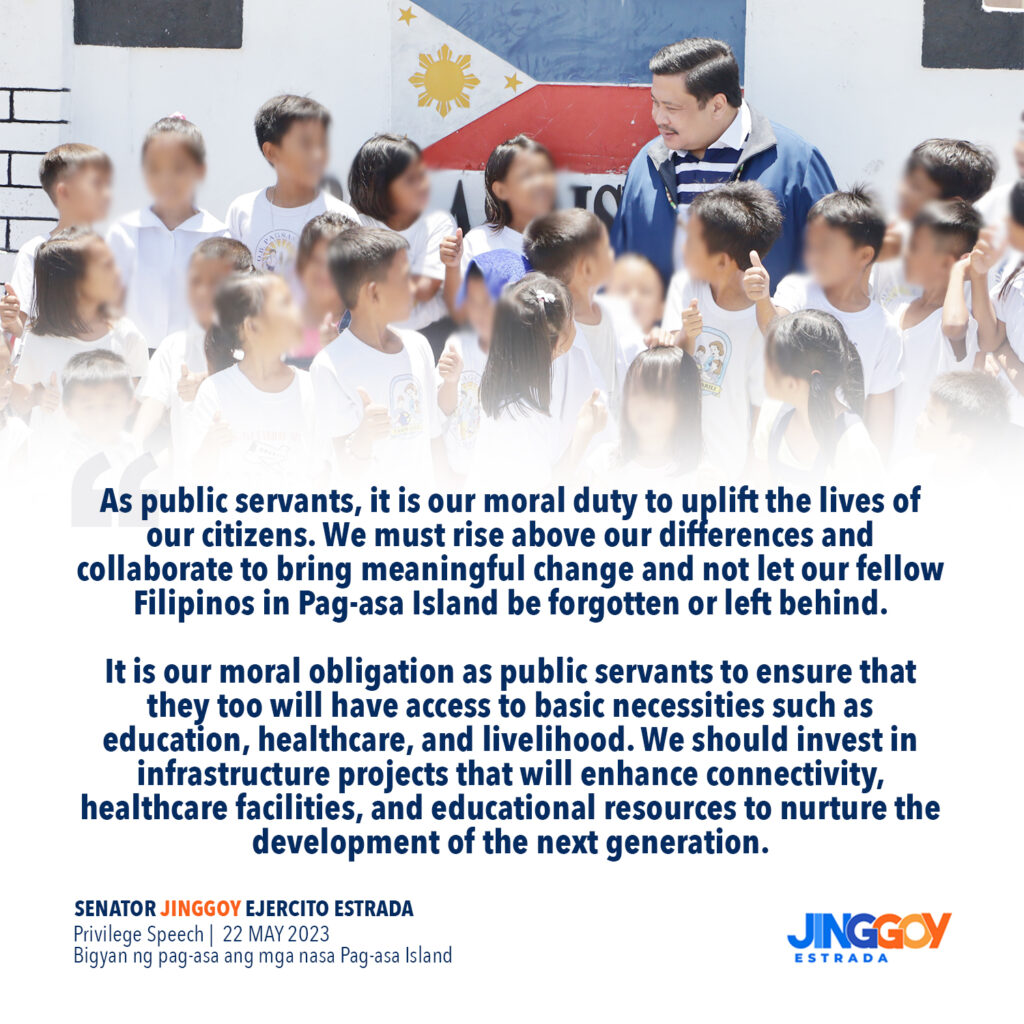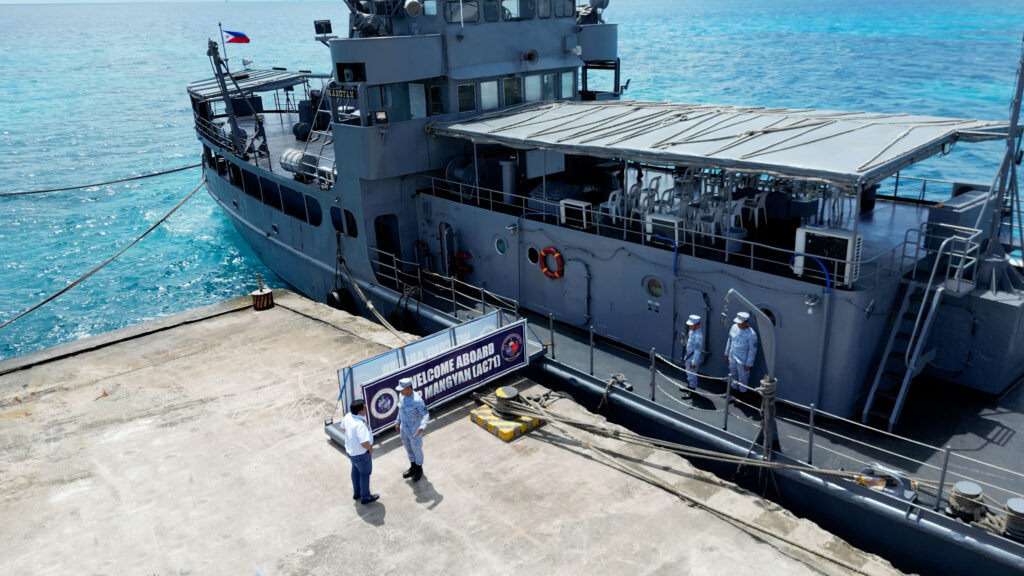Mister President, distinguished colleagues of this August chamber, ladies and gentlemen, I rise today on a matter of personal and collective privilege.
I rise before you with a heavy heart, encumbered by the plight of our kababayans in the remote and isolated Pag-asa Island – the largest landform of the Kalayaan Island Group which includes Ayungin Reef and Rizal Shoal and the islets of Lawak, Patag, Likas, Kota, Panata, Parola, and Pag-asa.
Kalayaan, a fifth-class municipality, is the least populated town in the Philippines. As of May this year, a total of 350 civilians or 65 households are currently living on Pag-asa Island, 73 of them are children.
To these 65 households, Pag-asa – its name pertains to a concept deeply rooted in the Filipino culture and reflects the resilience and unwavering spirit of the Filipino people – is their home.
Mr. President, last Thursday, May 18, I took a short visit to the Pag-asa Island along with Armed Forces of the Philippines Chief of Staff Gen. Andres Centino, Naval Forces West commanding general Alan Javier, Philippine Air Force commanding general Lt. Gen. Stephen Parreño, several other military officers and some members of the Senate media to look into its current situation.
To this day, the backdrops of what I saw continue to play in my mind. As I stand here, I cannot help but think of our kababayans who face countless challenges on a daily basis. For far too long, our brothers and sisters in Pag-asa Island have lived in constant uncertainty. They have endured the harsh realities of a life cut off from essential services and opportunities that many of us take for granted.
Their access to healthcare, education, and even the basic necessities of life is hampered by their geographic isolation. Their hopes and dreams often seem distant, obscured by the vastness of the sea that surrounds them.
Imagine dear colleagues being separated from your loved ones for months due to lack of transportation options. Sa mga pagkakataon ng pagkakaratay sa banig ng karamdaman, wala kang ospital na mapupuntahan o kahit man lang na health center na maasahan. Paano pa kaya sa mga kaso ng panganganak ng mga kababaihan? Kailangan pa silang i-airlift ilang buwan bago ang inaasahang petsa ng kanilang panganganak. Walang doktor, nurse o kahit na kumadrona na sasaklolo para masiguro ang ligtas na pagluwal ng sanggol.
Ang mga kabataang nasa elementary na nasa pitompu’t tatlo (73) ang kasalukuyang bilang, ay umaasa sa gabay at hinuhubog ng dalawang guro lamang. Tatlo paminsan-minsan kapag may sundalong nagboboluntaryong magturo sa kanila. At sa araw-araw na pagpasok nila sa eskwela ngayon sa nag-iisa na silid-aralan, hindi alintana ng mag-aaral na mula grades 1 to six ang sira-sira nilang kapaligiran na winasak ng Super Typhoon Odette noong Disyembre isa’t kalahating taon na ang nakaraan.
Halos magdadalawang taon na ang nangyaring delubyo ngunit ang mga bakas ng matinding pinsalang iniwan ng bagyong Odette ay naroroon pa rin.
This is the reality faced by our kababayans in Pag-asa Island: imagine dear colleagues the life when the power supply from the generator sets is cut off by ten in the evening. Imagine having no local radio stations. Imagine having cash in your pockets but seeing no need to use it as a medium of exchange simply because there are no economic transactions and financial activities in the area.
Two decades after opening the once strictly military installation to civilian settlement, the island has remained fallow. This, despite the construction of the beaching ramp which would allow shallow-draft vessels or those with roll-on/roll-off capability to bring in essential landing engineering equipment and other construction materials for the development of the island.
The repair of the Rancudo Airfield which sustained erosion damage is still ongoing. The 1.2-kilometer airfield that was constructed during the 1970s can accommodate only medium size military aircraft. We still have a long way to go if we are really keen on developing Pag-asa Island into a tourism and fishing destination or even a marine research hub.
Currently, missionary telecommunications service is being provided by Smart Communications which covers Pag-asa Island only. Though the signal is unstable, it has been very beneficial to the community and to the municipality’s operation. Other options for communicating are by the use of a Single-side Band (SSB) radio and of the military- operated very high frequency (VHF) radio band on the island. The military, however, has a very small aperture terminal (VSAT). It is a two-way satellite ground station or a stabilized maritime VSAT antenna that uses broadband data for the provision of satellite internet access even in remote areas like Kalayaan.[1]

As a member of this august body that represents the interests of the people of this Republic, it is my duty to bring to the fore their daily struggles and advocate for the attention and assistance they desperately need. Pag-asa is a real island that can sustain human life and community.
My dear colleagues, I implore each and every one of you to lend your unwavering support to the cause of our brothers and sisters in Pag-asa Island. Sa aking pakikipag-usap at maging sa panayam ng mga reporters na kasama ko sa mga residente doon, handa silang manatili doon kahit na kapos sila sa maraming bagay. They are more than willing to contribute to the island’s defense, survival and development.

As public servants, it is our moral duty to uplift the lives of our citizens. We must rise above our differences and collaborate to bring meaningful change and not let our fellow Filipinos in Pag-asa Island be forgotten or left behind.
It is our moral obligation as public servants to ensure that they too will have access to basic necessities such as education, healthcare, and livelihood. We should invest in infrastructure projects that will enhance connectivity, healthcare facilities, and educational resources to nurture the development of the next generation.
Let us also not forget the sacrifices made by our brave men and women in uniform who guard Pag-asa island with unwavering dedication. They, who face the brunt of the challenges and dangers posed by external forces, put their lives on the line to protect and defend our sovereignty. We owe it to them to support their mission by providing the necessary logistical support to carry out their duties effectively.
Sa aking pagbisita, napag-alaman ko na ang isang 78-year-old World War II-era Philippine Navy auxiliary ship, BRP Mangyan, ay isa sa mga ginagamit sa pagpapatrolya sa nasasakupan nating karagatan sa West Philippine Sea.

Ito rin ang nagdadala ng supplies s apitong Philippine outposts in West Philippine Sea. Mula sa kinalalagyan ng BRP Mangyan, tanaw namin ang nasa walo hanggang siyam na Chinese militia ships na dalawa hanggang tatlong nautical miles lamang ang layo mula sa shoreline ng Pag-asa Island.
My esteemed colleagues, let us not allow the remoteness of Pag-asa Island to be an excuse for neglect. Let us embody the spirit of solidarity and compassion that defines us as a nation.
Pag-asa Island may be a tiny dot on the map but its significance is immeasurable. It is not just a piece of land. It is a testament to our sovereignty, the indomitable spirit of our people, and a symbol of our determination of what is rightfully ours. And behind all of these, there are human lives – children, families, and individuals who are willing to live there in exchange for a peaceful life.
Bigyan natin ng pag-asa ang mga taga Pag-asa.
Thank you, and may we continue to serve our people with passion and empathy.
[1] https://www.kalayaanpalawan.gov.ph/mp.html

